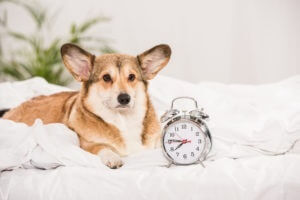How Time Changes Affect Your Dog’s Routine
Love it or hate it, most of us have to deal with the time change. Just when we feel like we’ve gotten used to gaining or losing an hour, we have to do it all over again. In the spring, we set the clocks ahead and lose a precious hour. In the fall, we dial our clock’s hands backward and gain an hour.

We don’t know about you, but every time we have to adjust the clock, we swear that this is the time change we hate the most. Other household members can be confused, too. Your pup may be wondering why its feeding time or entire routine has been nudged around by an hour.
Or do they? Does the time change affect our dogs the same way it does us? We really wanted to find out, and here is what we learned.
Dogs Can’t Tell Time…Can They?
Dogs can’t read a clock — it’s an obvious fact. There may be a talented canine somewhere out there that can successfully use a watch, but we doubt it. That said — dogs do tell the time in a non-traditional sense. Dogs are creatures of habit. If you don’t believe us, just try to miss a regularly-scheduled meal, and see how your best friend reacts.
The loss or gain of even an hour throws you off. The numbers on the clock may read 6:00 when the alarm goes off no matter what time of year it is but, for several weeks at least, that time is very different regardless of what the numbers say. When we change our clocks, we don’t reset our dog’s internal timekeeper. This can lead to a disruption of their internal senses that something should be happening now, not an hour earlier or an hour later.
Wondering how many of your dog’s habits are affected by the change in time? Keep reading.
Potty Breaks
Stop and think about it. Your dog tends to want to use the restroom reliably throughout the day. The first thing they want to do when the alarm goes off is to run outside for a wee. When they sense that you are getting ready for bed, they want to go out one last time before settling in for the night. Imagine things from your dog’s point of view:
Fall back:
“Hey Jim, good morning Jim, hey there Jim, it’s morning time Jim! I’ve had to go outside forever…get up Jim, let’s go, man! What is your problem, Jim? I’m literally crossing my legs here, human!”
Spring forward:
“Yawwwwwwwwwwwwwwwwn. What do you mean I have to go outside? I want to stay in bed. It’s warm in here. Stretcccchhhhhh. Nope. Not going to go. Why are you up? What’s going on?”
That single hour of difference means your dog has either been holding it for an extra 60 minutes, or you are trying to get her to go potty an hour before she’s used to going. How confusing! It can be especially difficult for a senior dog who has trouble holding it these days or a puppy you are trying to train.
Dinner Time
For some dogs, the time change won’t affect mealtime. These are the dogs who have food in their bowl constantly available and pick throughout the day. Other guardians feed their dogs at scheduled times during the day and evening. An hour’s difference for these canines can really upset their mood!
A hungry pup can get up to no good. Your dog may dig into the garbage in an attempt to feed themselves, they may chew up shoes or go after your remote control. A dog that is fed too early may turn up their snoot at their bowl, refusing to eat until they are good and ready. This, in turn, can throw your routine into a tailspin.
But…This Is Our Bonding Time
You lace up your sneakers and strap on your dog’s harness every day at 8 am. You sit on the couch every evening at 7 pm to binge-watch your favorite show before bed. Your dog learns your routine and comes to expect these things to happen. An hour can mean all the difference to your pooch who looks at you as the love of his life.
A pet whose routine is disrupted can become anxious. Anxiety can manifest itself in a variety of ways:
- Excessive chewing or licking
- Changes in hair coat or skin
- Negative or undesired behaviors
Try to remember that we are all our pets have. The sun rises and sets when we do. Once your dog and you have developed a daily routine, a minor disruption like time change can throw your dog into a tizzy.
Helping Your Dog Adjust to Time Changes
One of the best ways to help your dog adjust to the twice-yearly time changes is to adjust their inner clocks gradually. Try to change your routines by 10-minute increments until you’ve hit an hour difference. It should only take a week! For example:
If your dog’s schedule in the summer is to eat at 6 am and 6 pm, feed them when the clock says 5 am and 5 pm after the fall time change, adding 10 minutes to the time each day until you’re back at your 6 o’clock feedings.
If your dog’s schedule in the winter is to eat at 6 am and 6 pm, feed them when the clock says 7 am and 7 pm after the spring time change, reducing your time by 10 minutes each day until you’re back to 6 o’clock feedings again.
If you are able to change all of your dog’s routinely scheduled feedings, breaks, and exercise, you will have a canine that is better adjusted to the new times. Work schedules may not allow you to help your pet acclimate gradually in all areas of their lives, but try to meet them halfway in at least a few areas where it is possible.
A word about cats — they are affected just the same! Consider any routine that your feline friend has established in your household, and try to be sensitive to their needs when you change the clocks.
Greenlin Pet Resorts Is Here All The Time
We are as passionate about your pets as we are about our own. At Greenlin Pet Resorts, we offer services you and your furry friends will love. From cat boarding to dog training and everything in between, we are pleased to be able to offer valuable services to our treasured clients.
Whether daylight savings time is beginning or has just ended, we are here for you! Call us at a pet boarding and daycare facility near you today, or contact us online to discover more about our services and what we can do for you and your pets.
